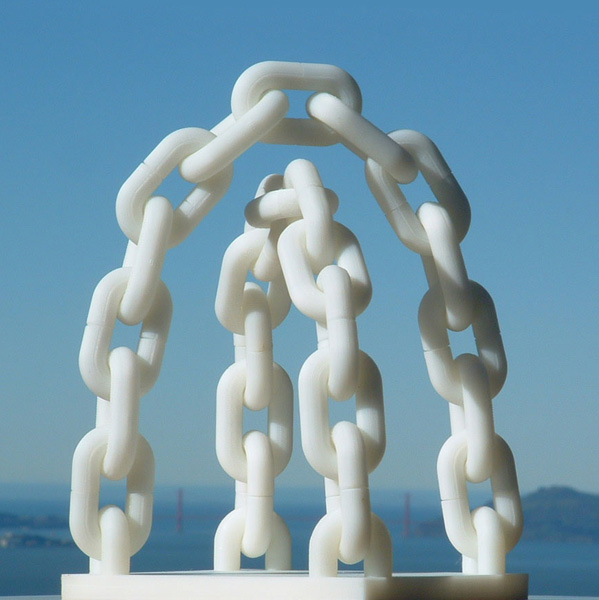Carlo H. Séquin |
"Defying Gravity"
White ABS plastic, (FDM) 5"x5"x7.5"tall, 2004.

Two criss-crossing chains displaying the classical catenary shape, but standing up rather than hanging down -- thus defying gravity.
"Klein Bottle with Fig-8 Cross Section"
Woven paper strands, 16" tall, 1997.

Klein bottles come in two
topologically different kinds:
the well-known "sock turned inside out" and the one produced by
sweeping a cross section
in the shape of a figure-8 around a loop while giving it a twist
of 180 degrees;
this is a woven model of the latter one.
"Solstice II"
Print of a computer model, 16"x16", 2009.

A program has been written to
emulate some of the tubular sculptures created by Charles Perry. This print shows a variant
of his sculpture "Solstice," which is based on a (3,2) torus knots. The basic knot, formed by
the thick rail, is straddled with 300 lightly curved ribs.
"Regular Maps on Cube Frames"
Paper models, 4"x4"x4" each model, 2009.

A small set of regular maps, all embedded in a genus 5 surface in the form a of a cube frame.
in particular, the models are:
(a) map R5.1, consisting of 64 triangles, based on
tessellation (3,8)
(b) map R5.1_dual, consisting of 24 octagons, based on
tessellation (8,3)
(c) map R5.4, consisting of 24 quadrilaterals, based on
tessellation (4,6)
(d) map R5.4_dual, consisting of 16 hexagons, based on
tessellation (6,4)
Carlo H. Séquin, Professor of Computer Science
EECS Computer Science Division, University of California, Berkeley
Berkeley, USA
"My professional work in computer graphics and geometric design
has also provided a bridge to the
world of art. In 1994 I started to collaborate with Brent Collins, a
wood sculptor, who has been
creating abstract geometrical art since the early 1980s. Our teamwork
has resulted in a program called
“Sculpture Generator 1” which allows me to explore many more complex
ideas inspired by Collins’ work,
and to design and execute such geometries with higher precision. Since
1994, I have constructed several
computer-aided tools that allow me to explore and expand upon many great
inspirations that I have received from several other artists. It also has resulted in many
beautiful mathematical models that I have built for my classes at UC Berkeley, often using the latest
computer-driven, layered-manufacturing
machines. My profession and my hobby interests merge seamlessly when I
explore ever new realms of
'Artistic Geometry'."